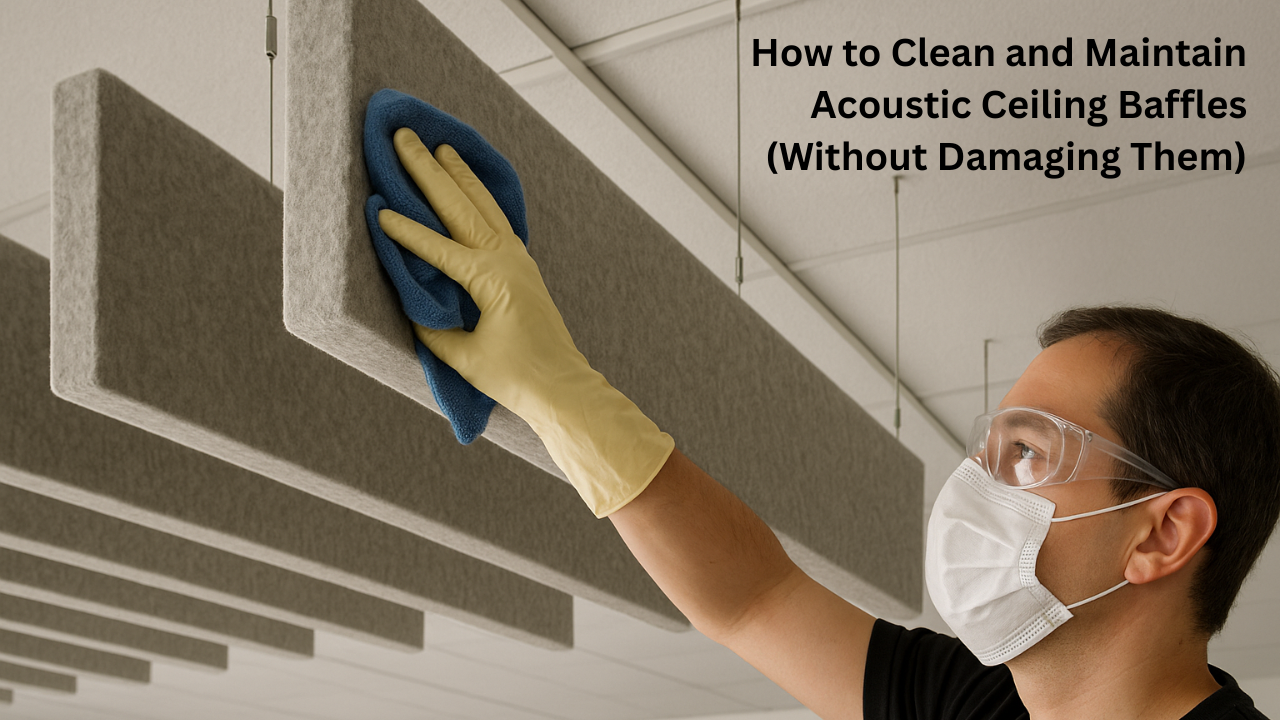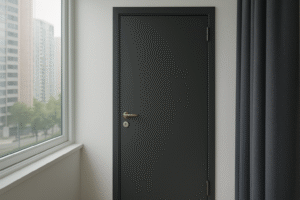A Complete Guide to Keeping Your Acoustic Ceiling Baffles Clean, Efficient, and Long-Lasting
In modern building design, achieving the perfect balance between functionality, aesthetics, and comfort is essential. One of the most effective ways to improve indoor acoustics is through acoustic ceiling baffles. These vertically suspended sound-absorbing panels play a crucial role in reducing echo, improving speech clarity, and enhancing overall acoustic performance in spaces such as offices, studios, classrooms, and restaurants.
While Hanging Baffles work quietly in the background to control noise and improve acoustics, over time they collect dust, dirt, and airborne particles. Just like any other interior fixture, these acoustic ceiling baffles require regular cleaning and maintenance to keep them performing efficiently and looking as good as new. However, because Hanging Acoustic Baffles are made from special sound-absorbing materials, they must be cleaned with care to avoid damaging the fibers or finishes.
In this detailed guide, we will walk through the correct and safe ways to clean and maintain acoustic ceiling baffles. You will learn how to preserve their performance, extend their lifespan, and keep your space fresh and comfortable for years.
Why Regular Cleaning Matters
It is easy to overlook ceiling baffles since they hang high above eye level, but ignoring them can lead to performance loss and hygiene issues. Regular cleaning helps maintain both aesthetics and acoustic quality.
1. Maintain Acoustic Performance
Dust and dirt can block the tiny pores that allow the panels to absorb sound effectively. By keeping them clean, you ensure consistent noise reduction and echo control.
2. Enhance Aesthetics
A clean ceiling contributes to a neat and professional appearance. Stained or dusty baffles can make even a well-designed space appear neglected.
3. Improve Air Quality
Airborne dust and allergens settle on the baffles and can be recirculated by HVAC systems. Cleaning removes these contaminants and contributes to a healthier environment.
4. Extend Lifespan
Proper maintenance prevents early degradation of materials, fabric discoloration, or warping. Clean baffles last longer and remain structurally sound.
5. Support Safety Standards
Dust accumulation near light fixtures or vents may create safety hazards. Regular maintenance helps keep your workplace safe and compliant.
Preparation Before Cleaning
Before cleaning, preparation is key. Follow these essential steps to ensure safety and prevent accidental damage.
- Turn off ventilation systems to prevent dust from spreading.
- Wear protective gear such as gloves, goggles, and a dust mask.
- Use a stable ladder or lift for access to higher installations.
- Read manufacturer guidelines if available, as materials differ in cleaning tolerance.
- Test cleaning solutions on a small, hidden section before applying to the whole surface.
This initial preparation helps you clean efficiently without harming the acoustic material or suspension system.
Step-by-Step Guide to Cleaning Acoustic Ceiling Baffles
Cleaning acoustic baffles is a delicate process. Follow these practical steps for safe and effective results.
Step 1: Inspection
Start by inspecting each baffle. Check for dirt, discoloration, sagging, loose mounts, or any signs of moisture damage. If you notice cracks or structural issues, call a professional before proceeding.
Step 2: Dust Removal
Use dry cleaning methods first. This is the safest and most common way to maintain the panels.
- Soft Brush or Microfiber Duster: Wipe the surface gently to lift dust particles.
- Vacuum Cleaner with Soft Brush Attachment: Move the vacuum slowly in one direction with low suction.
- Compressed Air: For tall ceilings or complex installations, compressed air can blow away dust without contact.
Clean from top to bottom so that falling dust does not soil already-cleaned areas.
Step 3: Spot Cleaning
If you find fingerprints, stains, or marks, do gentle spot cleaning.
- Mix mild detergent with lukewarm water.
- Dampen a lint-free cloth. Do not soak it.
- Blot the stained spot lightly.
- Rinse with a damp cloth to remove soap residue.
- Use a dry towel to absorb any remaining moisture.
Never use bleach, solvents, or alcohol-based cleaners as they can damage the fabric or reduce sound absorption.
Step 4: Deep Cleaning
In spaces like restaurants, factories, or gyms where grease or heavy dust accumulates, a deeper cleaning may be needed.
- Hire trained professionals who specialize in cleaning acoustic materials.
- Ask for low-moisture or dry-cleaning techniques.
- Avoid using water sprays, steam, or wet vacuuming that could cause the panels to deform.
A professional deep clean once every 12 to 18 months is ideal for maintaining both hygiene and appearance.
Step 5: Drying Process
After cleaning, ensure panels are completely dry before restarting air systems.
- Allow natural air circulation.
- Keep HVAC systems off until panels are fully dry.
- Avoid artificial heat or hair dryers that can warp materials.
Moisture left inside the fabric may lead to mold or odor, so patience during drying is essential.
Step 6: Final Check
Once cleaning is complete, check alignment, mounting security, and appearance. Tighten any loose fittings and make sure all baffles hang evenly.
How Often Should You Clean Acoustic Ceiling Baffles
Cleaning frequency depends on the type of environment and air quality in your space.
| Environment Type | Recommended Cleaning Frequency |
| Offices | Every 6 months |
| Schools and Colleges | Every 6 to 8 months |
| Restaurants and Cafés | Every 3 to 4 months |
| Industrial Areas | Every 3 months |
| Recording Studios | Every 12 months |
| Hospitals and Labs | Every 4 to 6 months |
Consistent light cleaning is more effective and less risky than rare deep cleaning sessions.
What to Avoid During Cleaning
To protect your acoustic panels, avoid the following practices:
- Using harsh or chemical cleaners
- Applying too much water or steam
- Scrubbing with rough cloths or brushes
- Using heat or blow dryers for drying
- Ignoring loose or tilted baffles
- Leaving moisture trapped inside
Gentle, minimal-moisture methods are always best for acoustic materials.
Long-Term Maintenance Tips
Beyond cleaning, long-term care keeps your panels in great shape and performing efficiently.
- Control Airflow
Do not install baffles directly under strong air vents to avoid constant dust buildup. - Maintain Ideal Humidity
Keep indoor humidity between 40 and 60 percent to prevent mold and sagging. - Check Suspension Systems Regularly
Inspect cables and clips to ensure safety and stability. - Avoid Continuous Sunlight Exposure
Prolonged UV exposure can fade the fabric or weaken the fibers. - Keep Maintenance Records
Note cleaning dates and observations for future reference and warranty tracking.
When to Replace Acoustic Ceiling Baffles
Even with consistent cleaning, all materials eventually wear out. You may need to replace your baffles if you notice:
- Stubborn stains or discoloration
- Fraying, tearing, or fabric peeling
- Visible sagging or bending
- Reduced noise absorption
- Persistent odors or mold growth
High-quality PET acoustic baffles typically last 10 to 15 years with proper maintenance. Timely replacement ensures your space continues to perform acoustically and visually.
Professional or DIY Cleaning: Which is Better
For light dusting and small installations, DIY cleaning is suitable. For large projects, high ceilings, or complex setups, hiring professionals is safer and more efficient.
Professional cleaners use specialized tools such as low-pressure vacuums and dry cleaning agents that remove dust and stains without damaging the Industrial Acoustic Baffles. They also follow safety standards for working at heights, ensuring proper handling of suspension systems and maintaining the structural integrity of the baffles during the cleaning process.
A balanced approach works best. Perform light maintenance regularly, and schedule professional cleaning once a year or as needed.
Keeping Your Baffles Looking New
To maintain the aesthetic appeal and performance of your panels:
- Wipe off dust frequently using a soft cloth or vacuum.
- Address any stains as soon as they appear.
- Keep doors and windows closed in dusty environments.
- Inspect panels after any construction or renovation.
- Plan a full cleaning at least once a year.
Consistent care will keep your ceiling baffles looking new and performing efficiently for a long time.
Ecotone Systems: Your Trusted Partner for Acoustic Ceiling Baffles and More
If you are looking for expert solutions in acoustic design, installation, and maintenance, Ecotone Systems Pvt. Ltd. is one of India’s leading providers of high-performance acoustic products. The company specializes in Acoustic Ceiling Baffles designed for superior sound absorption, aesthetic appeal, and long-term durability.
Ecotone Systems not only offers high-quality baffles but also provides a wide range of additional acoustic solutions, including Acoustic Doors, Acoustic Enclosures, and Anechoic Chambers. These products are engineered to meet demanding industrial, commercial, and architectural requirements. With a focus on innovation, precision, and sustainability, Ecotone Systems ensures every project achieves optimal noise control and acoustic comfort.
Whether you are designing a new workspace, upgrading an existing facility, or maintaining your current installations, Ecotone Systems delivers reliable, custom-made solutions backed by professional support and after-sales service.
Conclusion
Sound baffles are an excellent investment for any space that values comfort, clarity, and sound quality. Keeping them clean and well-maintained ensures they continue performing at their best for many years.
By following the right cleaning methods, avoiding harsh chemicals, and maintaining consistent care, you can protect their structure and sound-absorbing ability. Partnering with professionals like Ecotone Systems Pvt. Ltd. further guarantees expert guidance, quality installation, and long-term support for all your acoustic needs.
With proper care and maintenance, your acoustic ceiling baffles will not only maintain their function but also enhance the beauty and tranquility of your environment for years to come.





